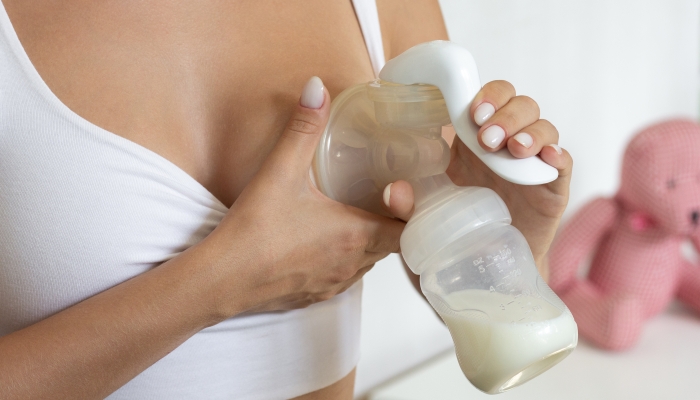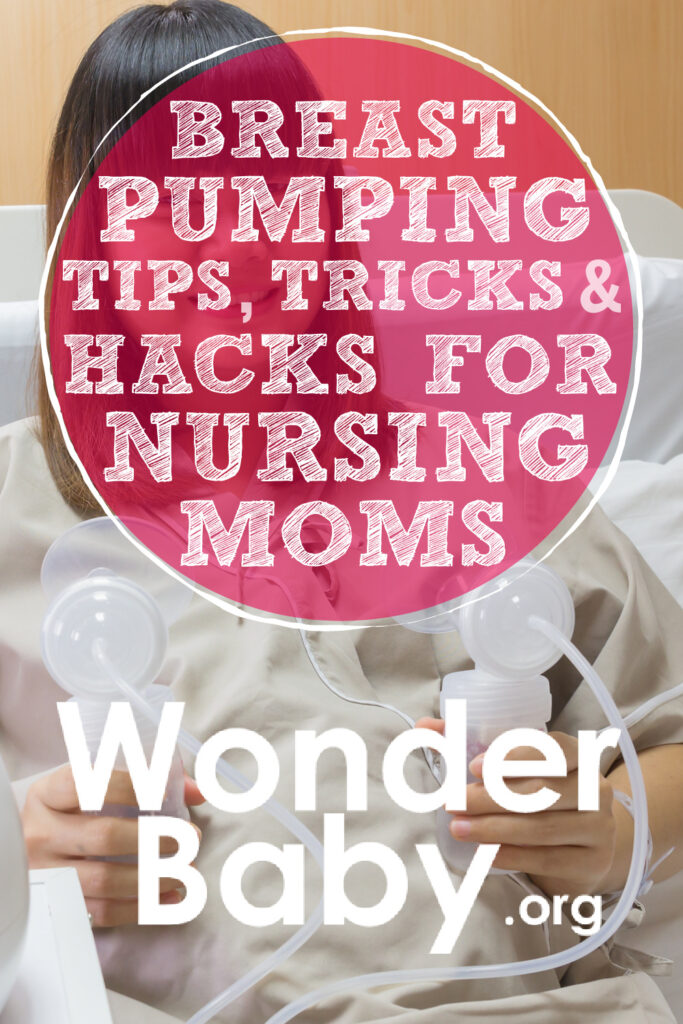11 Breast Pumping Tips, Tricks & Hacks for Nursing Moms

- Breast pumping regularly can help keep up your breast milk supply, prevent clogs, and avoid infection.
- Pumping after you breastfeed will encourage your breasts to produce more milk.
- Gently massage your breasts before pumping to help with milk flow.
- Ensure you are relaxed and comfortable before breast pumping to reduce unwanted stress or anxiety, which can decrease milk supply.
Whether you are exclusively pumping or pump occasionally, you likely are looking for the most efficient way to get the job done.
Pumping can become monotonous if it overtakes your day; however, there are ways to make pumping more enjoyable and increase your supply. While pumping breast milk isn’t difficult, there are some breast pumping tips and tricks you can try to make it more effective.
Breast Pumping Tips: What Nursing Moms Need to Know
Breast pumping isn’t the same experience as nursing, but there are specific tips every nursing mom should know. To keep your supply intact, you should pump any time your baby gets a bottle to encourage milk production.
Mothers who are mainly nursing can benefit from a breast pumping schedule to ensure they don’t forget when they are supposed to pump. You’ll likely notice you stick to pumping longer if you have a schedule and experience less discomfort from missing pumping sessions.
Before the baby arrives, it’s a good idea to have your breast pump ready and ensure you clean all infant feeding equipment. If you plan on pumping exclusively, you should start pumping after the baby is born; however, you should check with your lactation consultant for their recommendation.
While many big box stores carry breast pumps, mothers should know insurance covers breast pumps under the Affordable Care Act.
What Should You Not Do When Pumping
As tough as it may be, you should try not to pump while stressed. Motherhood is full of stressors, but when your body is tense, your cortisol levels rise, and you will not produce enough breast milk.
Avoid looking at the bottles, as this can cause stress if you don’t feel like you are producing enough milk. If it helps, you can place a blanket over your breasts to resist the urge to take a peek.
You should never cut a pumping session short, because you will not adequately empty your breasts. Over time, this will tell your breasts to make less milk, leading to a drop in supply.

5 Helpful Tricks to Pump More Effectively
1. Breast Pump Regularly
A common struggle with babies is putting them on a schedule, but did you know you might require one, too? Breastfeeding mothers whose babies also get bottles will notice a decrease in their milk supply if they aren’t pumping regularly. To keep the milk supply up, you should pump anytime your baby feeds.
For example, if your baby is at daycare and taking bottles, you should pump at home or work. While it seems tedious, missing pumping sessions can decrease supply and increase your chance of clogs, including mastitis, which can lead to a severe infection. If you can’t get to your pump in time, hand expression will help relieve pressure in your breasts.
While expressing milk doesn’t take the place of pumping, it can help prevent issues that lead to a decrease in milk supply. When you have access to your breast pump, you should empty your breasts to help keep up with breast milk production. Finally, ensure you put expressed milk on ice packs to keep that liquid gold fresh.
2. Check Your Breast Shield Size
A new breast pump typically comes with standard-size shields, but one size does not fit all. You need to use the correct size to pump milk effectively. If your nipples move freely, your shield is too big, but if you experience intense pain while pumping, the size is likely too small.
You can visit a lactation consultant if you are still determining the best size for your breast shield. If you have experienced pain from pumping, finding a nipple cream for breastfeeding will help current issues and prevent future cracking.
The good news is you can easily pick up new breast shields online or at your local big box store, and they don’t come with a high price tag.
3. Choose the Correct Breast Pump Suction
Some moms get enough milk from a low suction setting, while others need to crank it high to see any milk. You should put the setting on what is comfortable for you while still seeing a production of breast milk.
If you are not using an electric pump, you likely won’t run into this problem, but you should ensure pumping is never uncomfortable, even with a manual pump.
When you regularly pump, you will experience more discomfort over time if you use the incorrect suction during your pumping session.
4. Replace Damaged Pump Parts
Your pump parts can become damaged over time, especially if you pump frequently. If you notice a decrease in milk supply, you should inspect all the parts for damage. In addition, if you aren’t thoroughly cleaning pump parts daily, you could run into problems.
For example, the membranes on the pump’s valves are responsible for creating the necessary suction. If there is any damage or milk residue, they cannot operate correctly, and you won’t produce as much milk as you’d like.
You should also ensure your pump parts are completely dry before using, as moisture can affect how efficiently you pump.
5. Use an Electric Breast Pump
While a manual pump will produce milk, electric pumps are much more effective. For example, electric breast pumps usually have a longer suction due to their motor. An electric pump will let you express milk quicker, which is helpful, especially if you are on a pumping schedule.
Since there are various breast pumps on the market, you should find the one that works best for you. Some mothers don’t enjoy the feeling of an electric pump and prefer the manual methods. However you use a breast pump, it’s important to pay attention to how much milk you produce.
If you have recently switched from electric to manual and notice all the milk you used to pump has diminished, you should revert back to your original pump. Breast pumps can be finicky, so it’s best to stick with what works for you and optimizes your milk supply.

6 Helpful Hacks to Maximize Pumping Output
1. Power Pump to Boost Your Supply
Power pumping is used to mimic cluster feeding and tell your body to produce more milk. Mothers who want to add power pumping to their routine should pump several times within an hour while taking breaks in between each session. For example, you can pump for 15 minutes, break for 5, and continue the cycle until the hour is complete.
While power pumping is effective in boosting your supply, it can take several days of doing so to see results. If you notice tenderness in your breasts or find blood in the expressed milk, you should stop power pumping. Mothers with an adequate supply should avoid power pumping because it can lead to an oversupply.
2. Use a Warm Compress Before Pumping
Your breasts respond well to warmth, and using a warm compress before pumping can help with milk flow. Adding heat to your breasts is also a wise idea if you are prone to clogs, as it helps promote the breast milk to keep flowing. You can give yourself a breast massage while the compress is on to increase milk output.
You can use a warm washcloth or fill a sock with rice and warm it up in the microwave. It should go without saying, but ensure it is not too hot to scald your breasts.
3. Drink More Water
Nursing moms should always have a full glass of water nearby while pumping or breastfeeding to ensure they stay hydrated and keep their milk supply up. If you need help remembering to drink water throughout the day, make a point to always fill up a cup before you sit down to pump or begin your breastfeeding session.
Since breast milk is roughly 90% water, you must stay hydrated to produce more. The more you take in, the more you can put out. You need to drink more water than you would if you weren’t nursing. Any mom will likely tell you they’ve never been thirstier than they were while nursing or pumping.
4. Eat a Well-Balanced Diet
It’s easy for a pumping mom to forget to eat, but it’s vital for mothers to eat a sufficient diet to pump extra milk. Nursing and pumping mothers can add foods like leafy greens, oats, nuts, avocados, and flaxseeds to help with milk production.
In addition to eating a well-balanced diet for milk production, mothers will notice more energy when they include high-protein foods in their diet. Moms, don’t forget to take care of yourself while caring for your baby.
5. Allow for Multiple Letdowns
A letdown during pumping occurs when the milk begins flowing out of your breasts, and you likely turn the pump off when the flow stops. If you wait a few minutes and lean forward, you might get another letdown, filling your pumping bottles with more milk.
It’s best to put your pump back into letdown mode to encourage your breasts to have another letdown. You should expect trial and error with getting more than one letdown, but it can help you get another few ounces of breastmilk from your original session.
6. Pump After Nursing
To help boost their milk supply, mothers should breast pump after nursing their babies. While time won’t allow it every session, this signals to your body to make your milk. If you don’t have time to breast pump, you can express milk to keep the milk flowing.
When you sync your pumping with the baby’s schedule, you are more likely to continue pumping. To save time, you can also nurse on one breast while you pump on the other. However, this may take some practice, especially as your baby grows.

Related Posts

Breastfeeding, Sleep
Sleep and Breastfeeding: A Comprehensive Guide for Nursing Moms
Many people assume breastfeeding and sleep training don’t go together, but it is possible to help your baby sleep better while continuing your breastfeeding journey.

Breastfeeding
Comfort Nursing: Pros, Cons, and How to Stop
Find out what comfort nursing is, when should you worry about it, and how to stop or limit your baby's comfort nursing (especially at night!).

Breastfeeding, Product Reviews
5 Best Breastfeeding Chairs for Nursing Moms of 2023
Whether you want a gentle rock, a smooth glide, or a cozy cuddle to soothe your baby to sleep, you’ll have your pick of the best breastfeeding chairs on the...